Women’s pay gap hasn’t changed. Here’s why—and how to fix it

Canva
Women’s pay gap hasn’t changed. Here’s why—and how to fix it
A group of corporate professionals in a conference room.
The gender wage gap is a historic obstacle for women in the U.S. workforce. While income inequality is worse in some places than others, the average American woman can expect to earn less than her male counterpart, no matter what industry she chooses to pursue or how hard she works. However, research shows that where a woman decides to live can have a positive impact on her earning potential.
Using data from the 2021 American Community Survey (ACS) and the Bureau of Labor Statistics (BLS) and analyzing wage data for men and women working full-time, MoneyGeek determined the states with the largest and smallest gender wage gaps. We found that, on average, women made $11,180 less than men in 2021. Our analysis also examined the connection between a state’s wage gap and its partisan lean and the states where women’s wages have increased the most from 2020 to 2021. Let’s look at the facts.
![]()
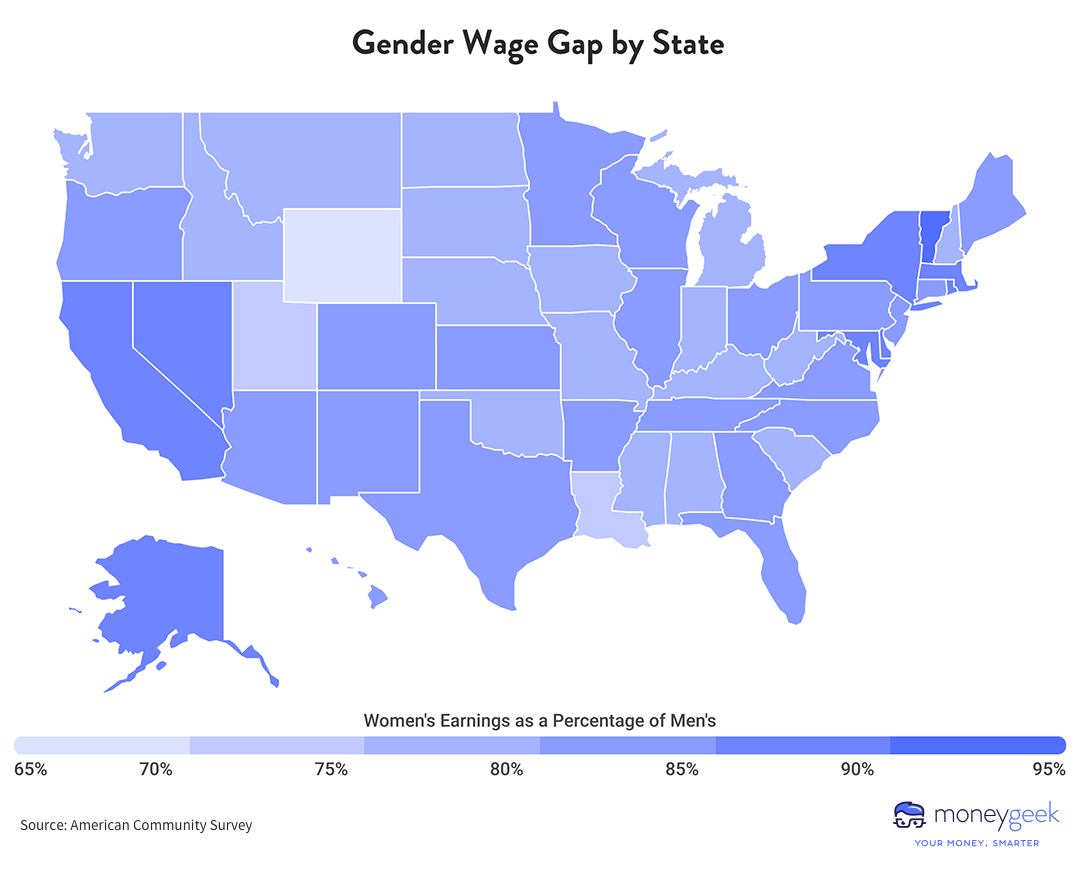
MoneyGeek
Key Findings
Heat map showing states with the largest gender wage gaps.
- Nationally, there hasn’t been significant progress closing the wage gap: women earned 83.0% of men’s earnings in 2021 compared to 81.2% in 2015, according to the BLS.
- The wage gap is smaller in Democratic-leaning states (83.6%) than Republican-leaning states (79.4%). Women earn 29.5% more, or $12,817 more, in blue states than those in red ones.
- Vermont has the smallest wage gap, where women earn 93.1% of men’s annual earnings. The widest wage gap is in Wyoming, where women earn 68.5% of men’s annual earnings.
- Women’s average annual earnings grew by 5.1% — or $2,375 — between 2020 and 2021. During that period, Rhode Island saw the biggest increase in wages for women with 11.9% wage growth.
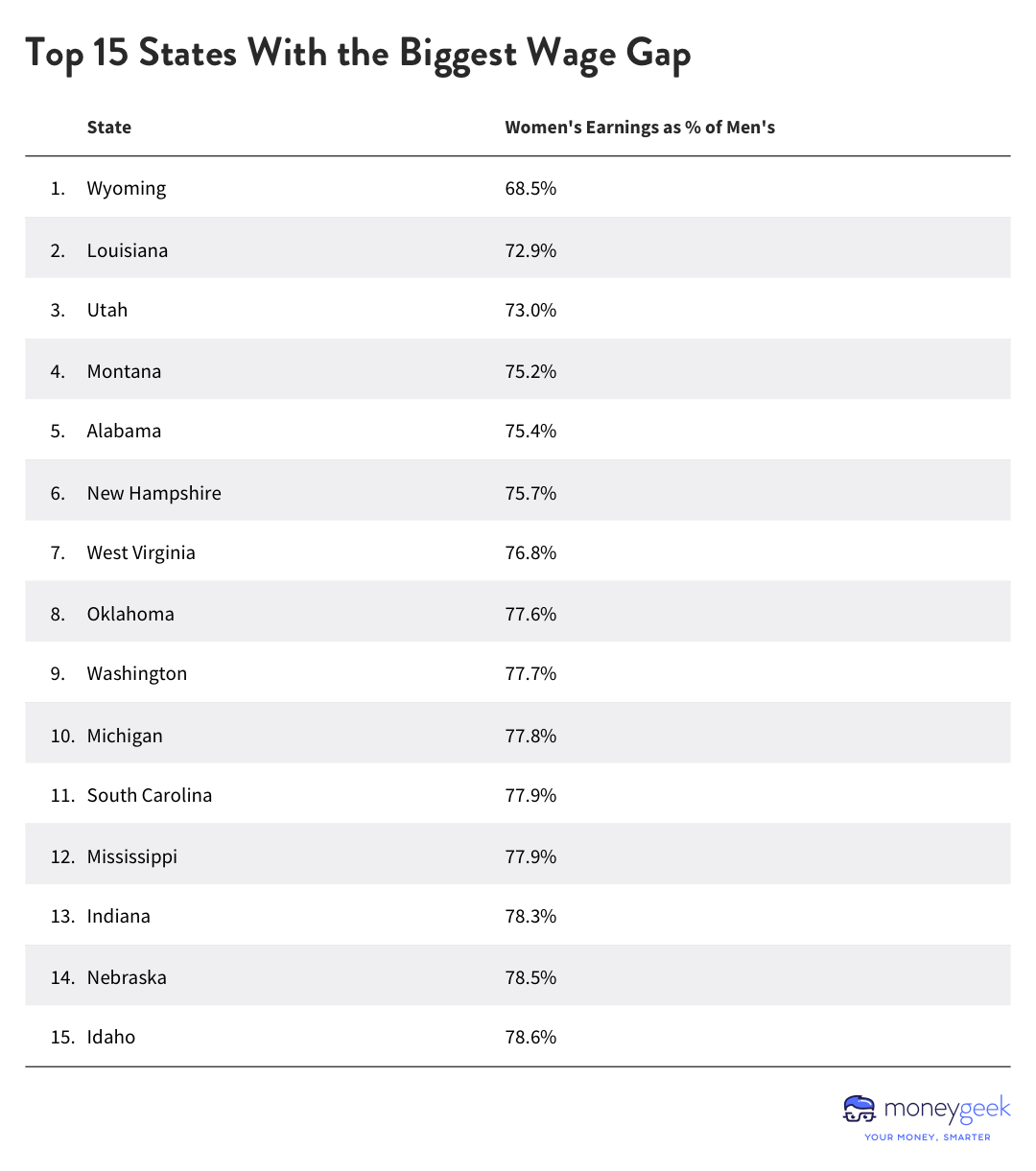
MoneyGeek
States with the largest gender wage gaps
Table showing Wyoming and Louisiana have the biggest wage gaps between men and women.
For women in America, earning potential doesn’t just depend on skills and effort. It is also determined by location. A previous MoneyGeek study identified cities with the largest gender pay gaps, but analyzing this gap at the state level adds other layers of complexity related to partisan lean.
Wyoming had the biggest gender wage gap in 2021, where women earned 68.5% of men’s earnings and the median income was $40,976. Women’s pay increased just 1% in Wyoming between 2020–2021, far below the national average of 5.1%. The next worst state is Utah, where women made 69.6% of men’s salaries. Louisiana is third at 72.9%, and following closely behind are Mississippi (73.2%) and Idaho (74.7%).
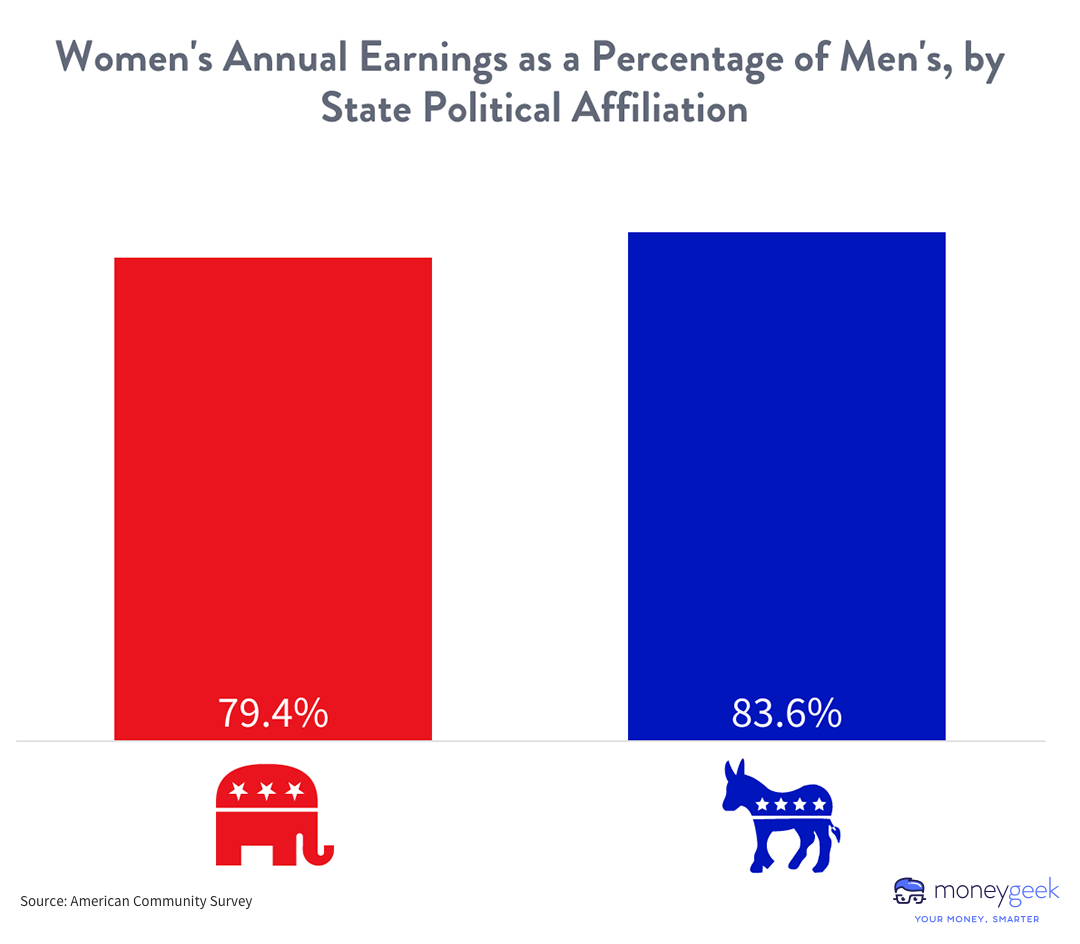
MoneyGeek
How partisan lean correlates with gender wage gaps
Bar chart showing how partisan lean correlates with gender wage gaps.
Eight of the 10 states with the biggest wage gaps in America lean Republican, while eight of the 10 with the smallest gaps lean Democratic. Our analysis shows that there is a notable difference in the gender pay gap between red and blue states.
Women in Democratic states earned 83.6% of men’s income in 2021, compared to 79.4% for women in Republican states. This means that women in red states earned 29.5% less than those in blue ones — a difference of $12,817 from 2020–21.
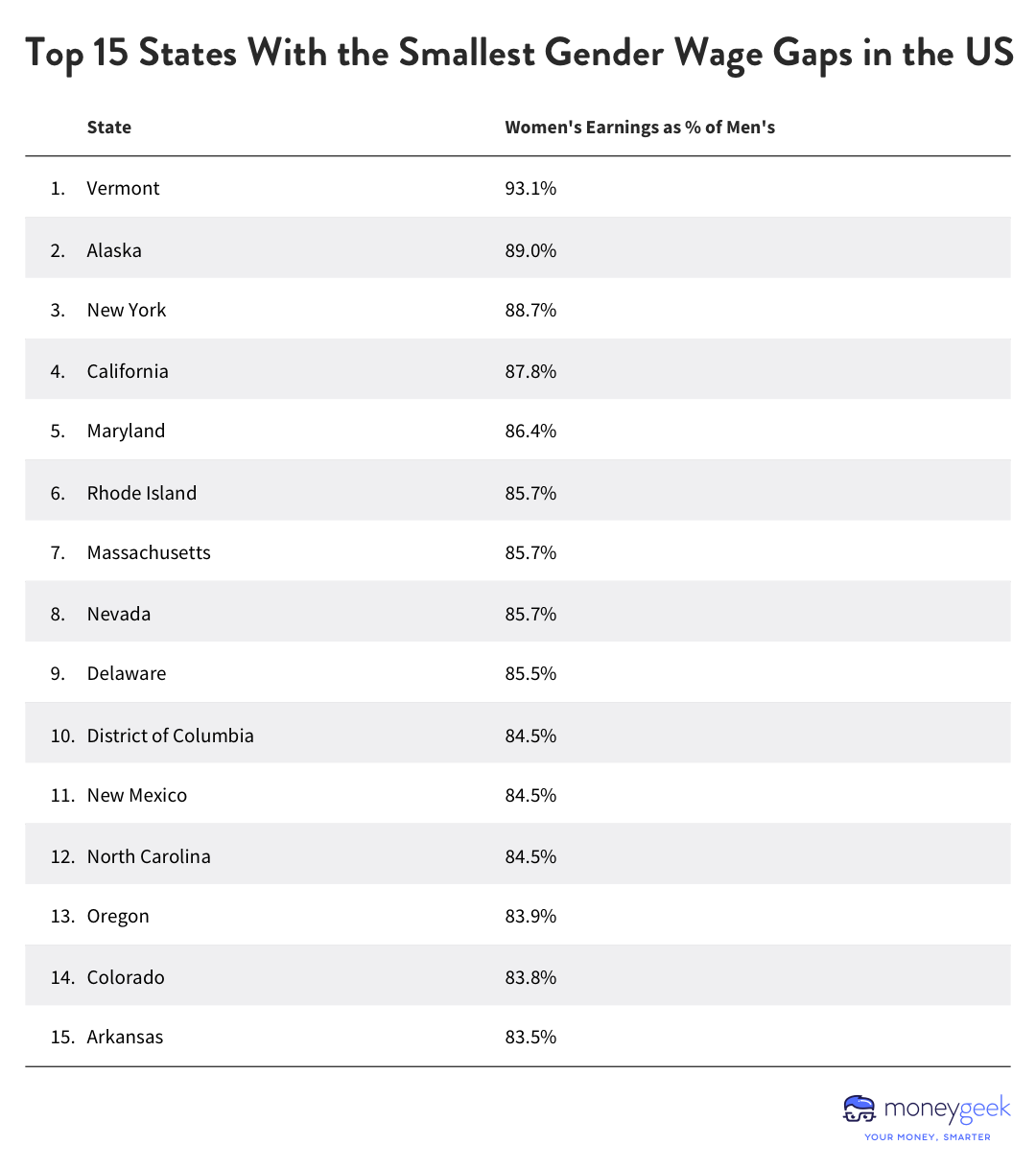
MoneyGeek
States with the smallest gender wage gaps
Table showing states with the smallest gender wage gaps.
The gender wage gap exists in every state in the U.S., but some have smaller gaps than others.
Vermont currently leads in pay equity. Women’s income in this blue state was 93.1% of men’s earnings between 2020–21, an annual difference of $3,872. Second is Alaska, where women earned 89.0%.
Understanding how states with the smallest wage gaps address pay equity can help policymakers develop solutions that support female economic empowerment across the country. According to a 2022 report by Moody’s, the U.S. economy could see a growth of $1 trillion within the next 10 years if the country put systems into practice to support female participation in the labor market.
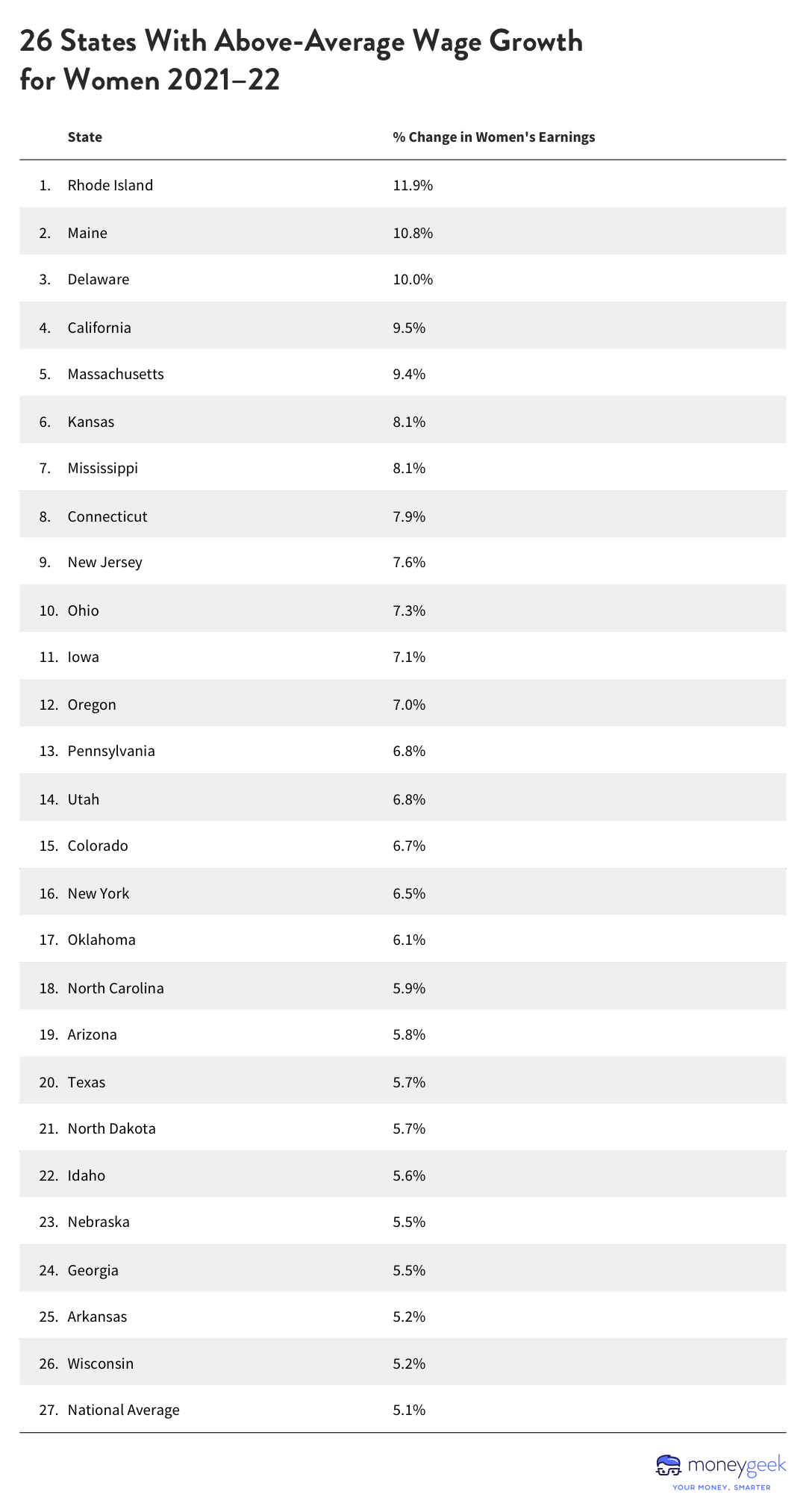
MoneyGeek
Where are wages growing fastest for women?
Table showing the 26 states with above-average wage growth for women.
Women seeking better economic opportunities may find it useful to examine states where women have the highest rates of wage growth. MoneyGeek’s analysis found that half of the 10 states with the smallest gender wage gaps also experienced above-average growth in women’s earnings from 2020–21. In Rhode Island, women’s wages increased 11.9% — the highest of any state. Maine’s gender wage gap puts it at number 20, yet even there women’s wages grew 10.8% — a close second. Anyone looking to relocate for better opportunities should consider things like cost of living in addition to wage differences to maximize their options.
How to improve the wage gap
The effects of the gender gap reach far beyond the zeros on a woman’s paycheck. They determine one’s access to education, ability to achieve financial independence, quality of life in retirement and the well-being of future generations. Unfortunately, while wages are growing for women in some states, the national pay gap has held steady in recent years.
On a national level, it’s important for the federal government to ensure equal pay by setting uniform salary policies, maintaining salary transparency and conducting contractor wage gap audits. To diminish income disparity, the government can also take steps to promote access to high-paying occupations for women of all backgrounds.
States such as Nevada, Maryland, and Oregon have already put salary history bans in place to reduce historical gender discrimination. This could explain, in part, why these states are among the top 15 states with the lowest gender wage gaps in the U.S. To take it a step further, state and local governments could implement fines or put incentives in place to encourage pay equality.
Because businesses determine how much money women make compared to men, they also play an important role in bridging the gender wage gap. By auditing for disparities, correcting salary discrepancies and putting fair hiring practices in place, companies can make strides toward greater equality.
Although wage inequality is still the norm, there are measures women take to close the gap. From moving to states with greater pay equity to voting women into government positions, starting your own business and making investments a priority, there has never been a better time for female financial empowerment.
Within a professional environment, women can also take steps to ensure fair pay by:
- Asking for promotions
- Negotiating pay increases
- Making bonuses and stock options part of their compensation packages

Canva
Methodology
An empty loft-like workspace.
MoneyGeek analyzed data from the 2021 American Community Survey to explore median wages of full-time workers by gender and by state to identify where wage gaps may be growing between men and women. We used data from 2020 to compare how wages have changed for women between states.
Additionally, we used data from FiveThirtyEight to find the partisan lean of each state, and data from the Bureau of Labor Statistics to report on national earnings differences between men and women as recently as 2021 and as far back as 2015.
SOURCES
- FiveThirtyEight. “How Red Or Blue Is Your State?.” Accessed February 16, 2023.
- Maryland General Assembly. “House Bill 123.” Accessed February 16, 2023.
- Moody’s. “Breaking the Bias.” Accessed February 16, 2023.
- Nevada Electronic Legislative Information System. “SB293.” Accessed February 16, 2023.
- Oregon Bureau of Labor & Industries. “Equal Pay.” Accessed February 16, 2023.
- The Center for American Progress. “Why Salary History Bans Matter To Securing Equal Pay.” Accessed February 16, 2023.
- The White House. “FACT SHEET: Biden Harris Administration Announces Commitments to Advance Pay Equity and Support Women’s Economic Security.” Accessed February 16, 2023.
- U.S. Department of Labor. “Bearing the Cost.” Accessed February 16, 2023.
- U.S. Bureau of Labor Statistics. “Median earnings for women in 2021 were 83.1 percent of the median for men.” Accessed February 16, 2023.
- U.S. Census Bureau. “American Community Survey (ACS).” Accessed February 16, 2023.
This story originally appeared on MoneyGeek and has been independently reviewed to meet journalistic standards.
